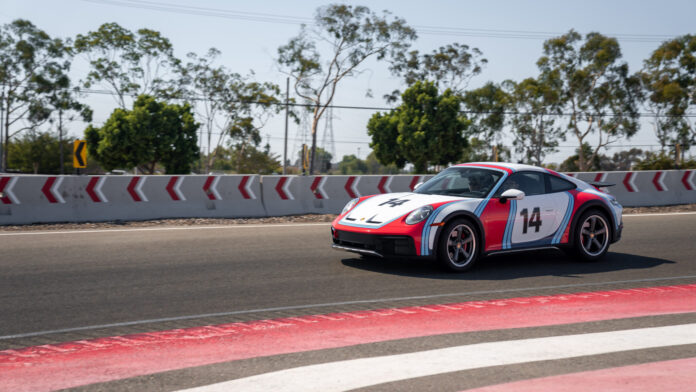You couldn’t miss it if you tried. Its lifted stance, widened fenders, and Fuchs-style five-spoke wheels make the Porsche 911 Dakar instantly recognizable. Adorn it with one of a handful of available liveries, and this limited production model, which began its development as a Carrera 4 GTS, makes an even stronger case for why you should shell out the $223,450 it demands.
Not that you could, though, even if you had the cash. With production restricted to just 2,500 units, the entire lot has long since sold. Meanwhile, peering at pre-owned values reveals asking prices well north of $300,000. As is typical of Porsche’s limited-run models, it’s likely already sold out by the time you’ve heard of it.
Why bother driving it then, you ask. The Dakar’s persona, like much of the 911 range, is multifaceted. While its marketing materials see it photographed in desolate places or tackling sandy dunes, the reality is that most will be stashed in collections by speculators or relegated to a life of pounding asphalt. Like the Lamborghini Huracan Sterrato, only a handful will ever be driven as intended. And so, its engineers haven’t built it to be an uncompromising off-roader. This is still a 911, after all, one that promises to be just as good on the trails as off them.
I’ll admit I’m pushing it to the other extreme here. When Porsche floated the idea of driving the Dakar for the first time at its Experience Center in Los Angeles rather than on the street or a carefully selected off-road course, I jumped at the opportunity. There’s a method to the madness, however. During the LA Auto Show in 2022, as I stood at a media preview for the Dakar, the carmaker sneakily mentioned that it’s as quick around the Nurburgring as a 996-generation 911 GT3, a fact that’s stuck with me since.
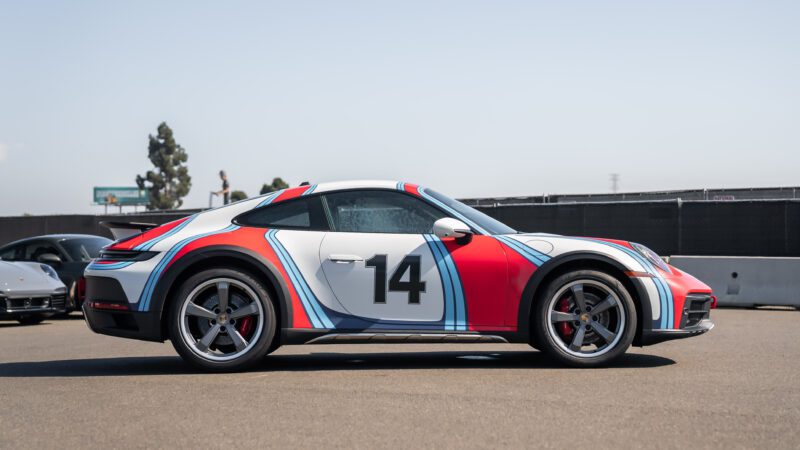
The Porsche Experience Center is an expansive facility in Carson, CA, less than 20 minutes from Los Angeles International Airport. It’s one of two PECs in the US; the first opened in Atlanta, Georgia, the home of the carmaker’s North American headquarters. In LA, the marque offers a driving experience in nearly every car it makes, ranging from a Cayenne S to the latest GT3 RS. Today, however, I’m here for the 90-minute session in the Dakar, an experience that’ll set you back $1,025.
Once checked in, you step past rows of preserved classics, a world-class workshop, a small cafe, and a full restaurant that makes up much of the building’s second floor. There’s plenty to do and even more to look at. Still, I was eager to get behind the wheel, so after a quick coffee, I met with the driving coach who would ride shotgun for the experience and stepped out to the PEC’s staging area.
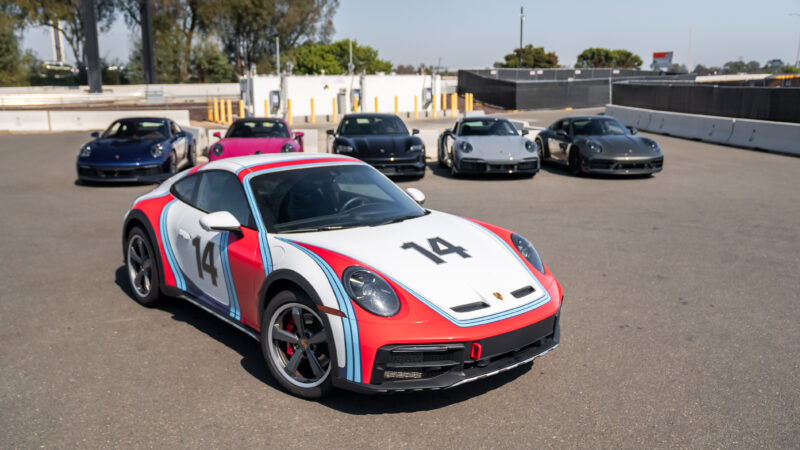
The Porsche 911 Dakar I’d be driving sat amongst a row of 718 Caymans, 911s, and Tacans of all flavors, wearing an optional Rally 1978 livery, a nod to the 911 SC Group 4 car Björn Waldegård drove in the East African Safari Rally that year. It sports a slick top devoid of a sunroof or any of the dozens of accessories available for it. Crucially for a day on the track, the staff at PEC had wrapped its five-spoke wheels with Pirelli P Zero summer tires.
While I understand the reasoning behind the decision to shelve its standard Pirelli Scorpion All Terrain Plus rubber, I was slightly disappointed. After all, Porsche developed the Dakar to be an off-roader first. While its options list does offer sets of summers and winters as extras, I wondered how much of its driving experience would now mirror that of the Carrera 4 GTS upon which it’s based. I sunk into its standard carbon fiber bucket seat fired up its flat-six and slowly crept onto the track.
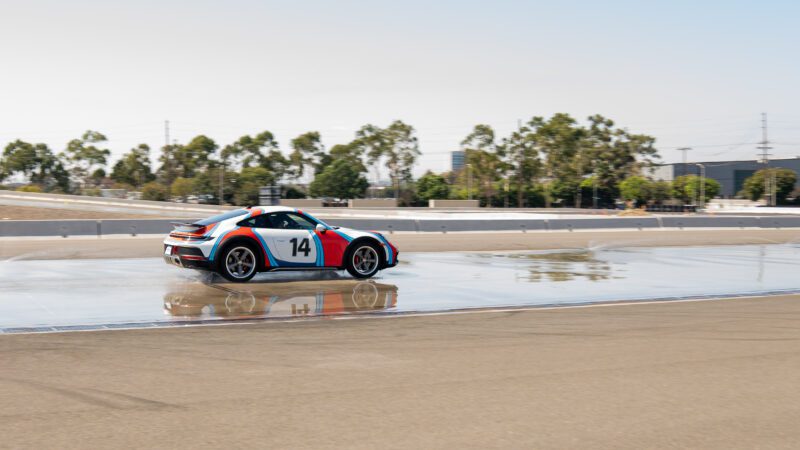
The Porsche 911 Dakar experience may only be 90 minutes long but has a choose-your-own-adventure feel. The crown jewel of the PEC is its 1.3-mile handling circuit. However, there are low-friction courses, a giant skidpad equipped with sprinklers to ensure you’re instantly sideways, a kick plat exercise to test your reaction times, and an off-road circuit. The latter is reserved for SUVs, so this is purely a track day.
We kicked off with a few runs on the kick plate, which, as its name suggests, uses a shifting metal panel that swings a car’s rear randomly to the left or right, simulating a hydroplaning event at highway speeds. It’s simultaneously a great test of your reaction times. Move too slowly, and you’ll complete a full loop before you even know what happened. Catch the initial slide, however, and the all-wheel-drive Dakar recovers with only a twitch of its back end. I suspect that something mid-engined, like a GT4 RS, would be more of a handful.
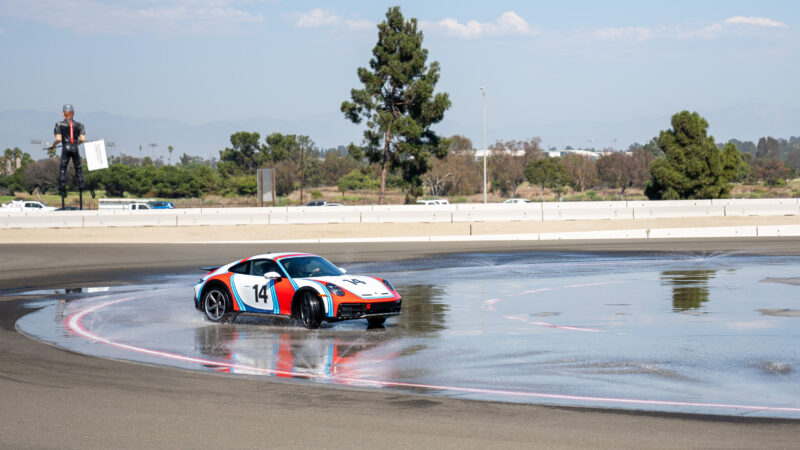
The skidpad and the most challenging part of the experience came next. With sprinklers raining on the surface, the giant donut-shaped course was ready for slides. I, however, was not. As I picked up speed on the course, my foot slowly came off the throttle while I tucked the nose towards the center of the track. I floored it and counter-steered to catch the slide. I did it precisely as I’ve done in countless rear-drive BMW M cars and as I did on an ice track with rear-drive V8 Maseratis. What I hadn’t done is remember that the Dakar is all-wheel drive.
Initiating proved easy enough; however, holding it was much more challenging. The Porsche 911 Dakar can hold extreme angles as it glides across a track sideways. It requires more throttle than steering input, and once in the drift, total commitment to the throttle to keep it going. Even as you feel you’re a split second away from looping it, it demands a steady feed of power. Grant its wish, and you’ll be rewarded with controllable drifts that don’t end with you facing backward. All it takes is a bit of mental rewiring.
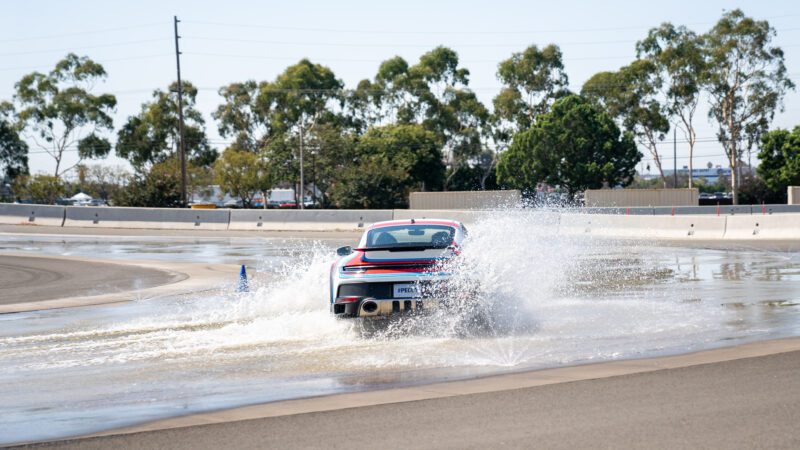
Before we pulled onto the 1.3-mile circuit, my instructor directed me to a short autocross course to familiarize myself with the Dakar’s performance on a dry surface. Within minutes, however, it was time for some citing laps.
The track experience kicks off from the right seat as the instructor gives you a tour of the track, pointing out braking zones and demonstrating the ideal racing line. Now, you also become aware of the many other cars you share the circuit with. As you pull out of a corner, you may see a GT4 RS creeping up from behind or catch up to a Carrera S on a cool-down lap. There’s more to the experience than just the track itself, and the instructor is constantly monitoring traffic to ensure everyone keeps their distance and passes only on designated zones.
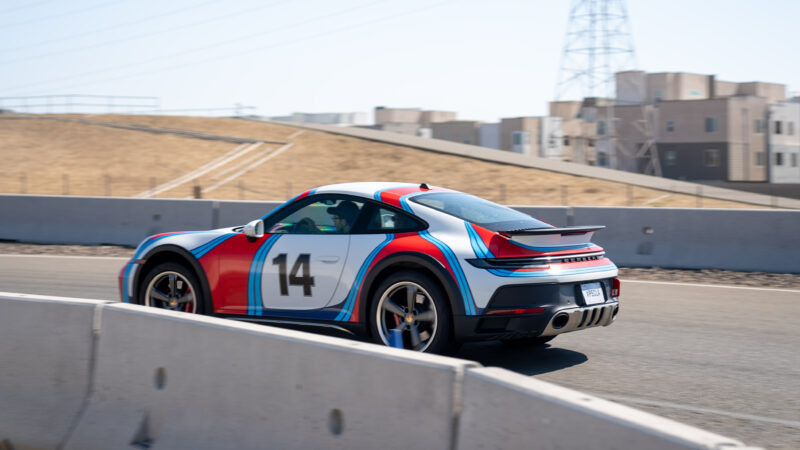
Back in the carbon buckets, I finally felt like I was getting to grips with the Dakar. Although much of it feels familiar with its cabin, GT sports wheel, and excellent visibility, some differences immediately emerge. For one, its stance. The Porsche 911 Dakar sits 1.9 inches taller than a Carrera equipped with a sports suspension. A standard lift system raises it a further 1.2 inches, a stature it maintains until you cross 105 mph.
Its hood, a gift from the GT3, and rear spoiler are carbon-fiber-reinforced plastic. A combo of lightweight glass and a lighter battery keeps its weight at 3,552 pounds. That’s 16 lb heavier than a 911 Carrera 4 GTS equipped with a PDK transmission. Yet despite weighing roughly the same, the Dakar sports additional underbody protection and a redesigned intake system.
The oily bits carry over from the Carrera 4 GTS largely untouched, with its twin-turbocharged 3.0-liter flat-six developing the same 473 horsepower and 420 pound-feet of torque output. It’ll sprint to 60 mph in 3.2 seconds and top out at 149 mph, with power going to all four wheels via an eight-speed PDK.
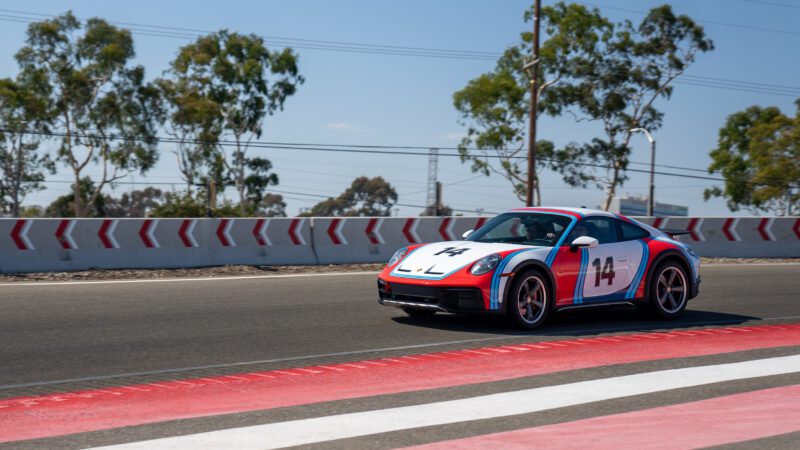
Picking up the pace as I learned the 1.3-mile track, I felt myself settling nicely into a rhythm behind the wheel. This may come as a shock, but equipped with summer tires, the Dakar drives like, well, a 911. Despite the lift, its handling is confident, and thanks to the Pirelli rubber, it delivers the grip you’d expect from a Carrera 4 GTS. I’d love to tell you that it leaned in the bends or felt drastically different, but that wasn’t the case. Even under hard braking zones, the nose never dipped considerably, nor did the back squat while shooting out the other side.
As anti-climatic as this revelation is, that also seems to be the Dakar’s secret sauce. Although Porsche developed it with off-roading in mind, I can’t help but remember the places where these cars actually live. Building a compelling off-roader is one thing, but its appeal would be limited if it only excels in that setting.

Yet that makes Dakar unique; it doesn’t ask you to choose. You can have the benefits of added ground clearance, a great ride, and the cool factor that is its unique aesthetic without sacrificing anything. Whether you go off-roading or, for whatever reason, you decide to take it to a track, it’s still as versatile as a 911 should be.

